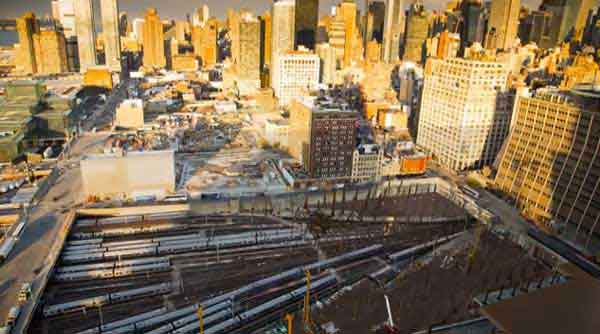
A planned $20-billion development in Manhattan—the largest private real-estate development in US history—relies on concrete-encased caissons to shore up six new skyscrapers and more than 17-million square feet of mixed-use space. Credit: Hudson Yards, YouTube.
New York City is known as the city that never sleeps.
In truth, NYC’s residents are better rested than you might think (sixth-worst city for sleep in America ain’t bad)—but it’s easy to see why they might have trouble catching Zs when living, working, and playing amongst some of the world’s most recognizable and renowned architecture (though sadly not its tallest).
And by 2018, Manhattan’s iconic skyline will morph once again, with the addition of mixed-use skyscrapers—the largest private real-estate development in US history—that “barely touch the ground.”
Say what?
Wired reports that the Hudson Yards development—a planned $20-billion, 17-million square feet of multi-use space that’s been described as “Jenga-esque”—is being built without footings or foundations. Instead, Hudson’s six skyscrapers, 100 shops, 20 restaurants, school, and 14 acres of parks will “sit atop 300 concrete-sleeved, steel caissons jammed deep into the underlying bedrock.”
The steel supports (similar to those used in construction of the Brooklyn Bridge) will allow the superstructures to float above West Side Yard—an existing and active train yard that provides overflow during rush hour—on a 37,000-ton platform.
As you can imagine, completing the platform’s construction with trains whizzing about requires coordination and 250 carefully placed concrete-encased caissons drilled 40 to 80 feet into the earth below. It also requires long (off) hours.
“The total punishment is somewhere in the neighborhood of 35,000 tons of steel and 50,000 cubic yards of concrete,” says lead platform engineer Jim White. “We look at the area of the yard and model in the train traffic, when it moves on an hourly basis, and actually design the connections so we can install these 100 foot long trusses when have a window of opportunity.”
Bloomberg reports that a large part of the work will be completed on weekends with 52 hours of “continuous shift work” that will drastically reduce the need to close tracks (as of now, only four track closures are expected).
Engineers anticipate that construction of the platform will be completed in two and a half years, and Related Companies, one of Hudson Yard’s developers, expects the entire project to wrap up by 2024.
To get an idea of what the project will look like—both during construction and upon completion—head on over to Gizmodo for some sweet gifs of the high-rise happenings at Hudson Yards.
Feature Image Credit: Hudson Yards, YouTube.




